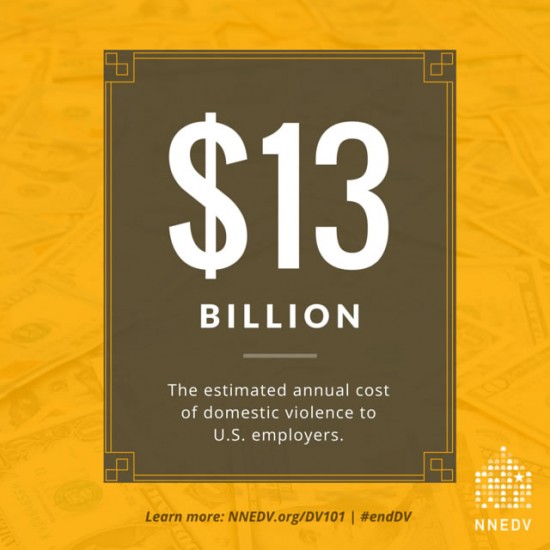Domestic Violence: a Public Problem and a Public Health Concern
April 7, 2016
Domestic violence is a pervasive, insidious, and life-threatening crime. While it is often regarded as a private, family matter—this is a misguided notion. It is time to prioritize survivors’ needs for a number of reasons—one of which is the devastating public health crisis that domestic violence presents.
Abusers often isolate victims from family, friends, and resources, which makes a potentially lifesaving visit to the doctor, health clinic, or emergency room incredibly difficult. Early intervention and access to services and resources are critical, because violence is almost always repeated, often escalates in severity over time, and can ultimately lead to acute and chronic health problems. Physical health consequences of domestic violence can include injury and death, gastrointestinal problems, chronic pain, sleeping and eating disorders, HIV/AIDS, sexually transmitted infections (STIs), miscarriage, and/or unwanted pregnancies. [1] Psychological ramifications can include depression, suicidal thoughts and attempts, lowered self-esteem, post-traumatic stress disorder, and/or alcohol and drug abuse. [1] The Affordable Care Act (ACA) recognized this concern and requires health plans to cover domestic and interpersonal violence screening and counseling. [2]
In addition to the negative impact on individuals and families, domestic violence and related crimes represent a significant cost to taxpayers and communities. According to figures from the Centers for Disease Control and Prevention (CDC), and adjusted to 2016 based on the Bureau of Labor Statistics Consumer Price Index, the cost of intimate partner violence exceeds $9 billion each year, $6.3 billion of which is for direct health care services. [3] Additionally, domestic violence costs American employers an estimated $13 billion each year. [4]
Each year, victims of domestic violence are forced to miss nearly eight million days of paid work. [5] Women who experience domestic violence work, on average, three months less than women who do not experience domestic violence. [6] Currently, only 17 states give survivors paid leave for necessities like going to court or to the doctor, which means millions of American women could potentially be fired if they had to miss work to take an abuser to court. [7]
Through this year’s Domestic Violence Counts Census, an advocate in Oregon shared one survivor’s story, in which the survivor suffered serious medical issues due to the abuse, “…she needed to go to her doctor who was 45 minutes away from the shelter and even further from her job. She is anxious because she cannot afford to take time off, and this seriously jeopardizes her health and ability to obtain self-sufficiency.”
Today is World Health Day, and we can act now to ensure that survivors have the resources they need to stay safe and healthy by passing life-saving legislation. The Healthy Families Act (H.R. 932/S. 497) sets a national standard for paid sick days. It allows workers to earn up to seven job-protected paid sick days per year, and allows victims of domestic violence, stalking, or sexual assault to use their paid sick days to recover. The SAFE Act (H.R. 3841/S. 2208) ensures that survivors do not have to risk their safety in order to protect their economic security. The SAFE Act allows survivors to take up to 30 days off from work within a year, including seven days of paid-time-off, consistent with the Healthy Families Act; receive medical attention, seek legal assistance, attend court proceedings, and get help with safety planning; and protects employees from being fired because of the abuse.
Show your support for legislation that empowers survivors here.
—
[1] Corrine Munoz-Plaza & Jean Capps, The Beacon Program, Planning and Implementing Response Programs in Healthcare Settings, page 6 (2001).
[2] Administration for Children and Families, HHS, (2013)http://www.acf.hhs.gov/sites/default/files/fysb/aca_fvpsa_20131211.pdf.
[3] National Center for Injury Prevention and Control. Costs of Intimate Partner Violence Against Women in the United States. Atlanta (GA): Centers for Disease Control and Prevention; 2003.
[4] Bureau of National Affairs Special Rep. No. 32, Violence and Stress: The Work/Family Connection 2 (1990); Joan Zorza, Women Battering: High Costs and the State of the Law, Clearinghouse Rev., Vol. 28, No. 4, 383, 385.
[5] U.S. Centers for Disease Control and Prevention. (2013, December 24). Intimate Partner Violence: Consequences. Retrieved 1 October 2015, fromhttp://www.cdc.gov/ViolencePrevention/intimatepartnerviolence/consequences.html.
[6] Adams, A. E., Bybee, D., Tolman, R. M., Sullivan, C. M., & Kennedy, A. C. (2013). Does Job Stability Mediate the Relationship Between Intimate Partner Violence and Mental Health Among Low-Income Women?. American Journal of Orthopsychiatry, 83(4), 600.
[7] Meredith Clark, This Bill Takes On An Often Overlooked Risk of Domestic Abuse, (Oct. 2015)http://www.refinery29.com/2015/10/96407/patty-murray-safe-act.






